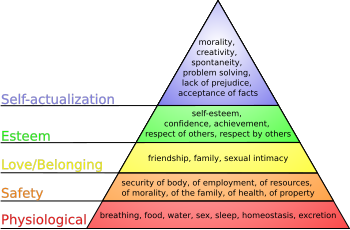Motivation and emotion/Book/2013/Self-esteem
What is it, is it good, and how to improve low self-esteem?
Overview
[edit | edit source]
|
Bella is sitting in her bedroom trying to finish her maths assignment, when she begins to think ‘Why am I finding this assignment so hard? I can’t even understand a simple assignment like this’. Upset with her progress she thinks to herself ‘I don’t even know why I try, I’m never going to amount to anything’. Bella decides to get up from her desk and looks in the mirror, and thinks to herself ‘I wish I had nicer skin, and wasn’t so short’. Staring in the mirror she thinks ‘No guy is ever going to date me, I have nothing to offer’. On the same night Shannon is trying to finish the same maths assignment. Finding the assignment equally as hard she thinks to herself ‘This assignment is so hard, maths really isn’t my subject. Luckily I’m doing really well in my favourite class - Psychology!’ Getting distracted, Shannon looks down at herself and begins to think about the way that she looks. Shannon happens to be much shorter than Bella, but has a different outlook on it. She thinks to herself ‘I really am quite short compared to other girls in my year, but I love being different to everyone else, I think it makes me much more appealing!’. Two girls, with two very different outlooks on life! This all comes down to their self-esteem. Self-esteem is one of the four constructs that make up a persons perception of themself, along with self-concept, self-knowledge and social self. This chapter will look at what self-esteem is, and the psychological theories surrounding it. Furthermore this chapter will cover low-self esteem, and ways to improve it. |
Self-esteem
[edit | edit source]|
Self-esteem is a construct within psychology that reveals a persons overall perception and value of their own self worth (Orth, Robins, & Widaman, 2012). The underlying basis of self-esteem is a persons beliefs, and associated emotions relating to themself. Beliefs about themself can include beliefs about their appearance, skills, personal characteristics and qualities, for example, the belief of ‘I am an attractive person’, or ‘I am not good at anything’. The mental picture that a person creates for themself, will begin to develop in early childhood and continue to expand throughout life. Through life experiences people will develop an image of how they see themself. Self esteem essentially encompasses three things: - the degree of acceptance and love a person believes they have from others - their feelings of worthiness and the ability to accept themself - confidence in the ability to use their skills and attributes in everyday situations (Bauemeister, Campbell, Krueger, & Vohs, 2003). There is an on-going debate for what self-esteem actually means for a person. Some studies suggest that having high self-esteem compared to low self-esteem is a good predictor for a person having a successful life (Bauemeister, Campbell, Krueger, & Vohs, 2003). Some studies however, suggest that self-esteem has no impact at all and can not be used to predict how a persons life will play out (Bauemeister, Campbell, Krueger, & Vohs, 2003). Self-esteem has long been considered an integral concept within psychology for determining a persons psychological well-being (Ross, Liu, Tomfohr, & Miller, 2013). There is accumulative research showing the relationship between psychological disorders such as depression and those with low self-esteem (Krueger, Vohs & Bauemeister, 2008). The study of self-esteem is not only important for the understanding of psychological disorders, but also on for understanding how it may have an impact on a persons development and overall outlook on life. |
Development
[edit | edit source]|
A persons self-esteem is continuously developed throughout their entire life, through life experiences (Orth, Robins, & Widaman, 2012). The development of self-esteem starts as early as childhood. Children are largely influenced by their parents at a young age to determine what is right and wrong. If a parent is constantly giving positive reinforcement to a child, the child is more likely to respond and do well (Rudy & Grusec, 2006). However, if a child is continuously given negative feedback, or told they are naughty, the more likely that that they will begin to believe it (Rudy & Grusec, 2006). As people go through life they will constantly be faced with judgements from family, friends, or other people of influence, all of which will have an impact on how the person sees themself – their self-esteem (Pelham & Swann, 1989).
|
Psychological theories
[edit | edit source]Measures of self-esteem
[edit | edit source]|
Self-esteem is generally measured through various self-report inventories that give a score revealing a persons degree of high or low self-esteem.
Click on the follow link to give the Rosenberg Self-Esteem Scale a go for yourself! http://personality-testing.info/tests/RSE.php
Click on the following link for a practicle example of the Implicit Association Test measuring self-esteem - http://www.millisecond.com/download/library/v3/IAT/SelfEsteemIAT.web Limitations[edit | edit source]Self-report is the main way in which self esteem can be measured - considering most questions to measure self-esteem are only known by the person. The biggest limitation of measuring self-esteem, as with any other psychological construct that is measured through self-report, is the susceptibility to social desirability. Due to social desirability people are more likely to answer questions that do not necessarily reflect their true identity, and sometimes will answer questions about their self-esteem that reflect someone with a higher level of self-esteem.
|
Types of self-esteem
[edit | edit source]
High self-esteem[edit | edit source]People with high self-esteem tend to be able to deal with life problems and experiences better than those with low self-esteem. Self-esteem is about how a person views themself, and those with high self-esteem generally have a high opinion of themself and their beliefs (Bauemeister, Campbell, Krueger, & Vohs, 2003). The benefits of having high self-esteem essentially fall into two categories: higher initiative and a feel good mentality (Bauemeister, Campbell, Krueger, & Vohs, 2003). A person who has high self esteem will generally exhibit the following characteristics - - Believe in their own values and opinions Secure and defensive high self-esteem[edit | edit source]Studies have shown that high self-esteem can take the form of both secure and defensive high self-esteem (Jordan, Spencer, Zanna, Hoshino-Browne, & Correll, 2003). Both forms of high-self esteem reflect a person with high opinions of themself, however a person with a defensive high self-esteem is vulnerable to criticism, and needs reassurance from others to maintain their positive view of themself (Jordan et al.,2003). A person with defensive high self-esteem may react very negatively if they are criticised and act out aggressively to anyone who does not agree with their opinions of themself. This is thought to be due to a person having high explicit self esteem, but low implicit self-esteem (Jordan et al.,2003). A study by Jordan et al. (2003) found that those with high explicit but low implicit self-esteem were more likely to have higher levels of narcissism and change their views to reduce cognitive dissonance. Those with secure high self-esteem, do not need reassurance of others for their self-worth (Jordan et al.,2003). Low self-esteem[edit | edit source]Individuals with low self-esteem generally take any sort of negative feedback very personally (Bernichon, Cook, & Brown, 2003). Any sort of criticism, whether it be relating to their friendships, goals in life or appearance – it can be very debilitating for some-one with low self-esteem (Bernichon, Cook, & Brown, 2003). A person with low self-esteem generally views their self-worth depending on how they think other people view them, and only see themself as worthy if they are succeeding at things in life (Bernichon, Cook, & Brown, 2003). A person with low self-esteem may exhibit some of the following characteristics: - Inability to deal with criticism Results from numerous studies have also found a link between self-esteem and depression. Some studies consider low self-esteem to be a risk factor for depression, whilst others conceptualize it as being part of depression (Orth et al.,2009; Sowislo & Orth, 2013). |
Improving low self-esteem
[edit | edit source]Summary
[edit | edit source]|
Self-esteem is a term used in psychology to define a persons overall perception of themself. People with high self-esteem tend to have a positive outlook on life and do not need the reassurance of others when making decisions. Within high self-esteem, there is also a difference across whether someone has a secure or defensive high self-esteem. A person with a defensive high self-esteem still requires positive reassurance of their beliefs about themself, where as a secure high self-esteem does not. People with low self-esteem, do not regard their opinions as being of importance and are constantly seeking reassurance from others, never thinking that they are good enough (Bernichon, Cook, & Brown, 2003). People with high self-esteem have been found to have higher initiative and a feel good mentality, so it would be fair to say high-self esteem is something that is well sort after(Bauemeister, Campbell, Krueger, & Vohs, 2003). People trying to enhance their self-esteem should look to methods for how to deal with life experiences, rather then just simply trying to improve their self-esteem directly or relying on positive feedback from others. |
Test yourself
[edit | edit source]Feeling confident? Give this short quiz a go to test your knowledge!
See also
[edit | edit source]Internal links
[edit | edit source]External support organisations
[edit | edit source]Lifeline: http://www.lifeline.org.au/
Beyond Blue: http://www.beyondblue.org.au
References
[edit | edit source]Bernichon, T., Cook, K. E., & Brown, J. D. (2003). Seeking self-evaulative feedback: The interactive role of global self-esteem and specific self-views. Journal Of Personality And Social Psychology, 84(1), 194-204. doi:10.1037/0022-3514.84.1.194
Conner, T., & Barrett, L. (2005). Implicit Self-Attitudes Predict Spontaneous Affect in Daily Life. Emotion, 5(4), 476-488. doi:10.1037/1528-3542.5.4.476
Demo, D. H. (1985). The measurement of self-esteem: Refining our methods. Journal Of Personality And Social Psychology, 48(6), 1490-1502. doi:10.1037/0022-3514.48.6.1490
Denissen, J. A., Penke, L., Schmitt, D. P., & van Aken, M. G. (2008). Self-esteem reactions to social interactions: Evidence for sociometer mechanisms across days, people, and nations. Journal Of Personality And Social Psychology, 95(1), 181-196. doi:10.1037/0022-3514.95.1.181
Greenwald, A. G., & Farnham, S. D. (2000). Using the Implicit Association Test to measure self-esteem and self-concept. Journal Of Personality And Social Psychology, 79(6), 1022-1038. doi:10.1037/0022-3514.79.6.1022
Huang, C., & Dong, N. (2012). Factor structures of the Rosenberg Self-Esteem Scale: A meta-analysis of pattern matrices. European Journal Of Psychological Assessment, 28(2), 132-138. doi:10.1027/1015-5759/a000101
Jordan, C. H., Spencer, S. J., Zanna, M. P., Hoshino-Browne, E., & Correll, J. (2003). Secure and Defensive High Self-Esteem. Journal Of Personality And Social Psychology, 85(5), 969-978. doi:10.1037/0022-3514.85.5.969
Krueger, J. I., Vohs, K. D., & Baumeister, R. F. (2008). Is the allure of self-esteem a mirage after all?. American Psychologist, 63(1), 64-65. doi:10.1037/0003-066X.63.1.64
Lester, D., Hvezda, J., Sullivan, S., & Plourde, R. (1983). Maslow's hierarchy of needs and psychological health. Journal Of General Psychology, 109(1), 83-85. doi:10.1080/00221309.1983.9711513
Lewis, H. (1988). Freudian theory and new information in modern psychology. Psychoanalytic Psychology, 5(1), 7-22. doi:10.1037/h0085119
Martijn, C., Vanderlinden, M., Roefs, A., Huijding, J., & Jansen, A. (2010). Increasing body satisfaction of body concerned women through evaluative conditioning using social stimuli. Health Psychology, 29(5), 514-520. doi:10.1037/a0020770
Maslow, A. H. (Ed.). (1954). Motivation and personality. New York: Harper
Orth, U., Robins, R. W., Trzesniewski, K. H., Maes, J., & Schmitt, M. (2009). Low self-esteem is a risk factor for depressive symptoms from young adulthood to old age. Journal Of Abnormal Psychology, 118(3), 472-478. doi:10.1037/a0015922
Orth, U., Robins, R. W., & Widaman, K. F. (2012). Life-span development of self-esteem and its effects on important life outcomes. Journal Of Personality And Social Psychology, 102(6), 1271-1288. doi:10.1037/a0025558
Pelham, B. W., & Swann, W. B. (1989). From self-conceptions to self-worth: On the sources and structure of global self-esteem. Journal Of Personality And Social Psychology, 57(4), 672-680. doi:10.1037/0022-3514.57.4.672
Ross, K. M., Liu, S., Tomfohr, L. M., & Miller, G. E. (2013). Self-esteem variability predicts arterial stiffness trajectories in healthy adolescent females. Health Psychology, 32(8), 869-876. doi:10.1037/a0031458
Rudy, D., & Grusec, J. E. (2006). Authoritarian parenting in individualist and collectivist groups: Associations with maternal emotion and cognition and children's self-esteem. Journal of Family Psychology, 20(1), 68-78. doi:10.1037/0893-3200.20.1.68
Sowislo, J., & Orth, U. (2013). Does low self-esteem predict depression and anxiety? A meta-analysis of longitudinal studies. Psychological Bulletin, 139(1), 213-240. doi:10.1037/a0028931


